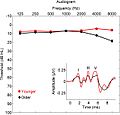Absolute threshold of hearing facts for kids
The absolute threshold of hearing (ATH) is the quietest sound a person can hear. It's the softest pure tone an average ear can pick up. This happens when there are no other sounds around. Think of it as the lowest level of sound your ears can detect. It's also called the auditory threshold.
For humans, the absolute threshold of hearing is about 20 micropascals (µPa). This is a very tiny amount of pressure. To give you an idea, this pressure is 20 billion times smaller than the normal air pressure around you! Your eardrum, called the tympanic membrane, works like a tiny sensor. It picks up these tiny changes in air pressure, just like a microphone does.
How We Hear Different Sounds
Our ears are not equally good at hearing all sounds. The quietest sound we can hear depends on its frequency. Frequency is how high or low a sound is. For example, a high-pitched whistle has a high frequency, while a deep drum has a low frequency.
Why Frequency Matters
Human hearing is most sensitive to sounds in the middle frequency range. This is where most human speech happens. This means we can hear these sounds even when they are very quiet. For very low or very high frequencies, the sound needs to be louder for us to hear it. This is why you might not hear a very high-pitched dog whistle, but a dog can!
Images for kids
-
Average hearing thresholds in decibels are plotted from 125 to 8000 Hz for younger (18-30 year olds, red circles) and older adults (60-67 year olds, black diamonds). The hearing of the elderly is shown to be significantly less sensitive than that of younger adults at frequencies of 4000 and 8000 Hz, corresponding approximately to the piano keys and tones of b′′′′ (B7) and b′′′′′ (B8), respectively. B8 is near the high end of the piano frequency range.
See also
 In Spanish: Umbral de audición para niños
In Spanish: Umbral de audición para niños


